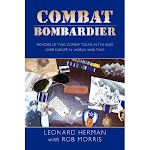
LOCAL JEWISH FILM FEST 2007
'Displaced' tells true story of survival
BY CATE MARQUIS, SPECIAL TO THE JEWISH LIGHT
"Displaced: Miracle At St. Ottilien" is a little-known "Greatest Generation" true story, about a couple of ordinary American G.I.s who showed extraordinary courage, persistence and intelligence to save some concentration camp survivors — after the war had ended.
This short documentary is narrated by writer Studs Terkel, and features interviews with the former American soldiers, two army privates named Robert Hilliard and Edward Herman, and a group of Buchenwald survivors in a displaced persons camp.
But what happened next to those survivors?
The Allied Commander was too busy, with mopping up after the war, hunting down the Nazi stragglers and putting the broken countries back in order, to really pay much attention to the barely-living concentration camp survivors who had been liberated. Those well enough could make their way home could but the sickly and weak, some far from home, or with no home left, were herded into displaced persons camps, often to be neglected or forgotten.
St. Ottilien was one such little camp, a former monastery, where a group of survivors huddled on the brink of starvation.
Army privates Robert Hilliard and Edward Herman were disturbed by this treatment and began smuggling food to the refugees.
When sickness broke out among the neglected survivors, the commanders thought of fencing them in, lest disease spread to the general population.
This was too much at last for Hilliard and Herman. They set out to do something about it, using their wits to circumvent the system, with a letter writing campaign. Eventually, their efforts got the attention of President Harry Truman.
The documentary's story is told through interviews with documents and archival stills.
The story is told step by step as it unfolded, leading up to the clever twist that did the trick. Survivors are interviewed along with the soldiers themselves.
The combination of cleverness, resourcefulness and determination to do the right thing, to save these strangers, makes this short documentary a heart-warming, inspiring winner.
I am continually amazed at the remarkable moral character and sense of right and wrong coupled with the brainiest and creative wit in being able to circumvent obstacles that marked this generation that grew up in the hardships of the Great Depression.
Maybe it was FDR's message of "we are all in this together" that cemented this determination to rescue the weakest and leave no one behind.
Displaced: Miracle At St. Ottilien is a wonderful little tribute, a bit belated, to some ordinary guys who did something extraordinary, just because it was the right thing to do."
 E. Edward Herman, Left, and Robert Hilliard, Right, were two American privates who changed US policy and saved the lives of thousands of liberated concentration camp survivors after World War Two. Never heard of them? Shame on you. Time to find out.
E. Edward Herman, Left, and Robert Hilliard, Right, were two American privates who changed US policy and saved the lives of thousands of liberated concentration camp survivors after World War Two. Never heard of them? Shame on you. Time to find out.
 Incredible detail on the RC model by Mr. Pagel.
Incredible detail on the RC model by Mr. Pagel. Bit o' Lace fired up and ready for take-off.
Bit o' Lace fired up and ready for take-off.
 This model is absolutely amazing!
This model is absolutely amazing!




 In a future entry, I'm going to deal with the Great Escape. I've been a student of the actual escape and a fan of the movie it inspired for many years. However, I got to thinking today about the outstanding spoof, Chicken Run, that was produced about six years ago by the same folks who brought us Wallace and Grommett. This claymation movie is about a chicken farm and the attempts of its ill-treated inmates to escape, but it is, in effect, a spoof on every WWII escape film ever made, especially The Great Escape.
In a future entry, I'm going to deal with the Great Escape. I've been a student of the actual escape and a fan of the movie it inspired for many years. However, I got to thinking today about the outstanding spoof, Chicken Run, that was produced about six years ago by the same folks who brought us Wallace and Grommett. This claymation movie is about a chicken farm and the attempts of its ill-treated inmates to escape, but it is, in effect, a spoof on every WWII escape film ever made, especially The Great Escape. Our hero tunnels in the secret tunnel in Chicken Run. Note the spoon he is using as a shovel.
Our hero tunnels in the secret tunnel in Chicken Run. Note the spoon he is using as a shovel. Steve McQueen makes 'the jump' into neutral territory in the climatic scene of 'The Great Escape'.
Steve McQueen makes 'the jump' into neutral territory in the climatic scene of 'The Great Escape'. Our hero makes his own jump in Chicken Run.
Our hero makes his own jump in Chicken Run.


 Leonard's plane, Ten Nights in a Bar Room/The Brass Rail, limps home from Trondheim, Norway, on fire and alone.
Leonard's plane, Ten Nights in a Bar Room/The Brass Rail, limps home from Trondheim, Norway, on fire and alone.


 An Army Air Corps schematic of the Sperry Ball Turret.
An Army Air Corps schematic of the Sperry Ball Turret.








 Stewart posed for this LIFE cover in the town square of his home town of Indiana, Pennsylvania.
Stewart posed for this LIFE cover in the town square of his home town of Indiana, Pennsylvania.










 In Norris wartime log and journal, two pictures of the remains of his plane and a cartoon of his plane he drew while in captivity.
In Norris wartime log and journal, two pictures of the remains of his plane and a cartoon of his plane he drew while in captivity. Shortly before her fateful final mission, Sugarfoot's crew had a naked lady painted on the front of their B-17. This piece was retrieved from the wreckage of the plane by the man who shot her down, Colonel Ruegg, and he kept it in his home as a war trophy. Norris's piece fits directly below the piece shown here.
Shortly before her fateful final mission, Sugarfoot's crew had a naked lady painted on the front of their B-17. This piece was retrieved from the wreckage of the plane by the man who shot her down, Colonel Ruegg, and he kept it in his home as a war trophy. Norris's piece fits directly below the piece shown here. The Swiss president, President Gisen, who visited Norris in the hospital after the demise of Sugarfoot.
The Swiss president, President Gisen, who visited Norris in the hospital after the demise of Sugarfoot. A wooden piece of Sugarfoot's radio room, the first piece of the plane Norris received from a Swiss friend, who had recovered it shortly after the plane crashed.
A wooden piece of Sugarfoot's radio room, the first piece of the plane Norris received from a Swiss friend, who had recovered it shortly after the plane crashed.


 Above, Norris's wartime log, given to him by the YMCA in Switzerland. He kept records, pasted in articles and photos, during his long and often boring stay.
Above, Norris's wartime log, given to him by the YMCA in Switzerland. He kept records, pasted in articles and photos, during his long and often boring stay. Norris, above, holds his wartime log. He covered the log with fabric from his parachute--the chute that saved his life after he bailed out of the waist section at 12,000 feet.
Norris, above, holds his wartime log. He covered the log with fabric from his parachute--the chute that saved his life after he bailed out of the waist section at 12,000 feet. The memorial page, above, and Norris's graduation photo from gunnery school, proudly holding his .50 caliber waist gun.
The memorial page, above, and Norris's graduation photo from gunnery school, proudly holding his .50 caliber waist gun.

 The cover of a Swiss photo weekly shows the first American internees captured in Switzerland.
The cover of a Swiss photo weekly shows the first American internees captured in Switzerland.

 Below, Norris's identity papers as a Swiss internee.
Below, Norris's identity papers as a Swiss internee.
 Above, Norris made these aerial gunner's wings from Plexiglas from the nose a crashed bomber. Above the wings is his leather squadron patch from the 99th Bomb Group, 15th Air Force.
Above, Norris made these aerial gunner's wings from Plexiglas from the nose a crashed bomber. Above the wings is his leather squadron patch from the 99th Bomb Group, 15th Air Force. The buttocks and thigh section of Sugarfoot's naked lady, now on display in Norris's computer room. He got it fifty years after the war. Compare it to the one in Ruegg's home higher up in this article.
The buttocks and thigh section of Sugarfoot's naked lady, now on display in Norris's computer room. He got it fifty years after the war. Compare it to the one in Ruegg's home higher up in this article. Marilyn and Norris King and Rob Morris in the King home, Arvada, CO, Sunday August 13, 2007
Marilyn and Norris King and Rob Morris in the King home, Arvada, CO, Sunday August 13, 2007




